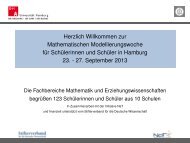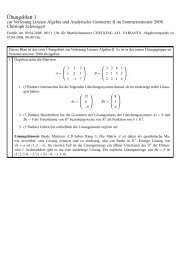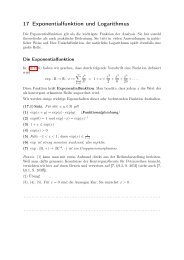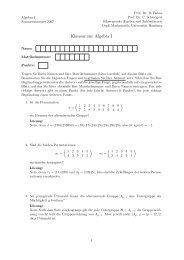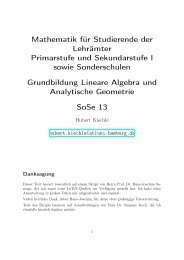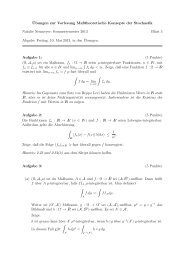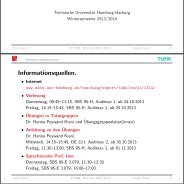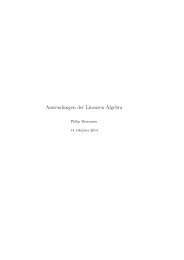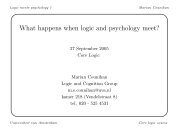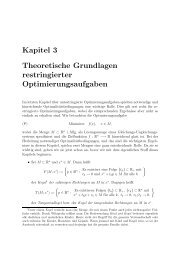pdf file
pdf file
pdf file
You also want an ePaper? Increase the reach of your titles
YUMPU automatically turns print PDFs into web optimized ePapers that Google loves.
3 Finite-dimensional Hopf algebras<br />
3.1 Hopf modules and integrals<br />
The goal of this subsection is to introduce the notion of an integral on a Hopf algebra that is<br />
fundamental for representation theory and some applications to topological field theory. Hopf<br />
modules are an essential tool to this end.<br />
Definition 3.1.1<br />
1. Let H be a K-Hopf algebra. A K-vector space V is called a right Hopf module, if<br />
• It has the structure of a right (unital) H-module.<br />
• It has the structure of a right (counital) H-comodule with right coaction Δ V : V →<br />
V ⊗ H.<br />
• Δ V<br />
is a morphism of right H-modules.<br />
2. If V and W are Hopf modules, a K-linear map f : V → W is a map of Hopf modules, if<br />
it is both a module and a comodule map.<br />
3. We denote by M H H the category of right Hopf modules. The categories HM H , H M H and<br />
M are defined analogously.<br />
H<br />
H<br />
Remarks 3.1.2.<br />
1. We have in Sweedler notation with Δ V (v) = v (0) ⊗ v (1) where v (0) ∈ V and v (1) ∈ H<br />
Δ V (v.x) = v (0) .x (1) ⊗ v (1) ∙ x (2) for all x ∈ H, v ∈ V .<br />
2. Any Hopf algebra H is a Hopf module over itself with action given by multiplication and<br />
coaction given by the coproduct.<br />
3. More generally, let K ⊂ H be a Hopf subalgebra. We may consider the restriction of the<br />
right action to K, but the full coaction of H to get the category of right (H, K)-Hopf<br />
modules M H K .<br />
4. Given any H-module M, the tensor product M ⊗ H is a right H-module by using the<br />
product on H. Using Δ M⊗H := id M ⊗ Δ as a coaction, one checks that it becomes a Hopf<br />
module.<br />
5. In particular, let M be a trivial H-module, i.e. a K-vector space M with H-action defined<br />
by h.m = ɛ(h) ∙ m for all h ∈ H and m ∈ M. In this case, the right action is (m ⊗ k).h =<br />
m ⊗ k ∙ h. Such a module is called a trivial Hopf module.<br />
We also need the notion of invariants and coinvariants:<br />
Definition 3.1.3<br />
Let H be a Hopf algebra.<br />
1. Let M be a left H-module. The invariants of H on M are defined as the K-vector space<br />
M H := {m ∈ M | h.m = ɛ(h)m for all h ∈ H} .<br />
This defines a functor H−mod → vect(K). For invariants of left modules, the notation<br />
H M would be more logical, but is not common. Similarly, invariants are defined for right<br />
H-modules.<br />
53




